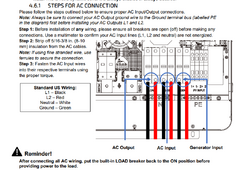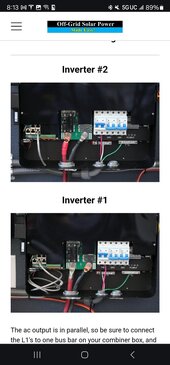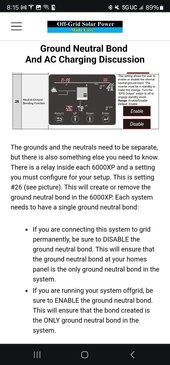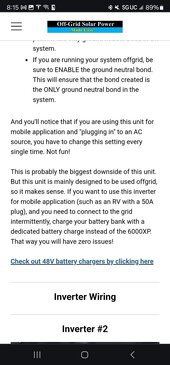I was watching @Will Prowse latest video again on the 6000XP showing two units in parallel. In it at 6:06 he talks about the grid connections. He used a NEMA 6-50P plug to supply the Grid Input for the XP's pass through and battery charging. That plug doesn't carry a neutral wire. That makes sense because the 6000XP can't use a 120v feed for the grid in connection, it must be a 220v connection. Several of us have tested this.
So, given that, it seems like you could create a bond in the off grid panel or in the 6000XP AND have a Grid Input connection safely, without any unwanted neutral loops. No one is discussing this way of wiring the 6000XP.
The manual does say to "use a multimeter to confirm your AC Input lines (L1, L2, and neutral)" (screen shot below) so that implies it expects a neutral however I don't know why. I want to create the N-G bond at the off grid panel or at the inverter AND also have a 220v grid input for pass through/charging.
I'd love to hear other's thoughts on this.
Will also states @ 8:03 wrongly in the video that the 6000XP can dynamically switch the N-G bond based on if it is in pass through mode or not. That isn't the case based on everyone's testing that I've seen so far. And it even says in the manual (screen shot below) that it is either on or off, not dynamic (at least not today). Maybe in a future update...
 .
.

v
So, given that, it seems like you could create a bond in the off grid panel or in the 6000XP AND have a Grid Input connection safely, without any unwanted neutral loops. No one is discussing this way of wiring the 6000XP.
The manual does say to "use a multimeter to confirm your AC Input lines (L1, L2, and neutral)" (screen shot below) so that implies it expects a neutral however I don't know why. I want to create the N-G bond at the off grid panel or at the inverter AND also have a 220v grid input for pass through/charging.
I'd love to hear other's thoughts on this.
Will also states @ 8:03 wrongly in the video that the 6000XP can dynamically switch the N-G bond based on if it is in pass through mode or not. That isn't the case based on everyone's testing that I've seen so far. And it even says in the manual (screen shot below) that it is either on or off, not dynamic (at least not today). Maybe in a future update...
 .
.
v







